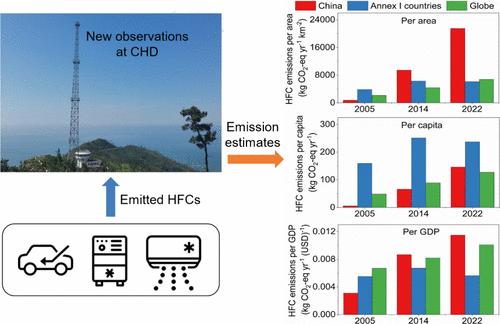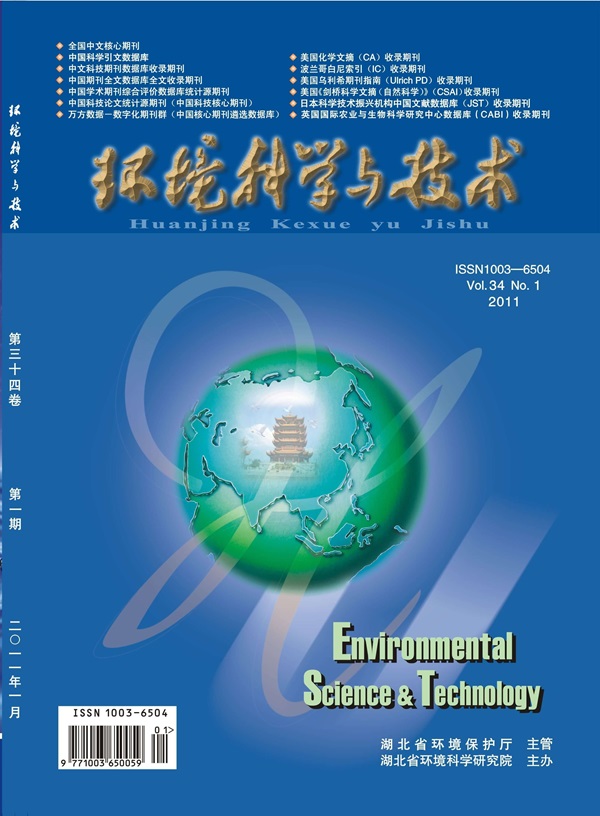Sustained Increases in Hydrofluorocarbon Emissions from China and Implications for Global Emissions
IF 10.8
1区 环境科学与生态学
Q1 ENGINEERING, ENVIRONMENTAL
引用次数: 0
Abstract
Hydrofluorocarbons (HFCs), which are potent greenhouse gases and widely used as replacements for ozone-depleting substances, are controlled under the Montreal Protocol. China is considered an emission hot region of HFCs, however, the observations and emission quantifications are still insufficient. In this study, we report new high-frequency in situ observations of HFC-125, HFC-134a, and HFC-143a at the Changdao (CHD) station, whose emission sensitivity to northern China is higher than those of previously used stations to better quantify emissions. Combining these observations at CHD with an inverse modeling approach, we present the most recent emission estimates for northern China and reveal the distinct spatial distributions of HFC emissions that have not been previously uncovered, facilitating different priorities of provinces in future controls for HFCs. Subsequently, we show that the combined CO2-equivalent emissions of these HFCs in China increased rapidly from 7.1 ± 2.5 Mt CO2-equivalent yr–1 (2.2 ± 0.8% of global totals) in 2005 to 206.4 ± 15.9 Mt CO2-equivalent yr–1 (20.3 ± 1.8% of global totals) in 2022. Finally, we reveal that in terms of per area, per capita, and per gross domestic product, CO2-equivalent emissions of HFCs in China were increasing fast and becoming larger than the global average level. Our new high-frequency in situ observations of HFCs and ongoing observations are crucially important to assess the historical and future emission evolution of HFCs under the Montreal Protocol.

中国氢氟碳化合物排放量持续增长及其对全球排放的影响
氢氟碳化物(HFCs)是一种强效温室气体,被广泛用作消耗臭氧层物质的替代品,受《蒙特利尔议定书》管制。中国被认为是 HFCs 的排放热点地区,但观测和排放定量仍然不足。在本研究中,我们报告了在长岛(CHD)站对 HFC-125、HFC-134a 和 HFC-143a 进行的新的高频原位观测,其对中国北方的排放敏感性高于之前使用的观测站,可以更好地量化排放。结合在长岛站的观测结果和逆向建模方法,我们得出了华北地区的最新排放估算值,并揭示了以前未曾发现的 HFC 排放的独特空间分布,从而有助于各省在未来 HFCs 控制中确定不同的优先事项。随后,我们展示了中国这些 HFCs 的二氧化碳当量排放总量从 2005 年的 7.1 ± 2.5 兆吨二氧化碳当量年-1(占全球总量的 2.2 ± 0.8%)快速增长到 2022 年的 206.4 ± 15.9 兆吨二氧化碳当量年-1(占全球总量的 20.3 ± 1.8%)。最后,我们揭示了从单位面积、人均和单位国内生产总值来看,中国的氢氟碳化物二氧化碳当量排放量正在快速增长,并已超过全球平均水平。我们对 HFCs 的新的高频原位观测和持续观测对评估《蒙特利尔议定书》下 HFCs 的历史和未来排放演变至关重要。
本文章由计算机程序翻译,如有差异,请以英文原文为准。
求助全文
约1分钟内获得全文
求助全文
来源期刊

环境科学与技术
环境科学-工程:环境
CiteScore
17.50
自引率
9.60%
发文量
12359
审稿时长
2.8 months
期刊介绍:
Environmental Science & Technology (ES&T) is a co-sponsored academic and technical magazine by the Hubei Provincial Environmental Protection Bureau and the Hubei Provincial Academy of Environmental Sciences.
Environmental Science & Technology (ES&T) holds the status of Chinese core journals, scientific papers source journals of China, Chinese Science Citation Database source journals, and Chinese Academic Journal Comprehensive Evaluation Database source journals. This publication focuses on the academic field of environmental protection, featuring articles related to environmental protection and technical advancements.
 求助内容:
求助内容: 应助结果提醒方式:
应助结果提醒方式:


